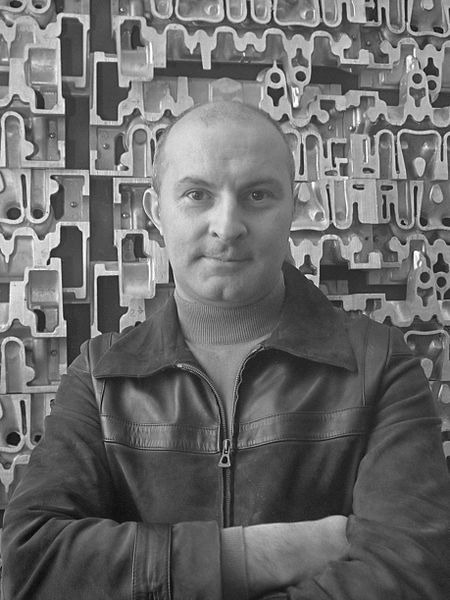
Arman
Renowned French artist Arman, fueled by disillusionment with the state of the world, developed his unique, recognizable style: a strategy of accumulating diverse images and objects to create assemblages or collages, all without the use of glue.
Biography of Arman
Armand Pierre Fernandez was born in Nice, France, in 1928. His father was a multi-talented individual, being an amateur artist, photographer, cellist, and antique dealer. Consequently, young Armand was introduced to the world of art at an early age, delving into oil painting and photography.
The artist embarked on a prolific journey of creating his initial drawings and paintings, signing them solely with his first name, akin to one of his artistic influences, Vincent van Gogh. This naming convention remained a constant throughout his career, except for one notable anecdote concerning a missing "D" in his name. In 1958, his name was mistakenly spelled as Arman due to an error by the printer on a catalog cover. Accepting this twist of fate, the artist decided to embrace the new name and signed all of his future works as Arman for the remainder of his life.
Arman obtained a bachelor's degree in Philosophy and Mathematics in 1946. Subsequently, he made a dedicated commitment to pursue an art career and enrolled at the École Nationale des Arts Décoratifs in Nice. Later, he transitioned to the field of history at the École du Louvre, completing his studies in archaeology and oriental art in 1949. Throughout this period, Arman held a deep fascination for the works of Jackson Pollock and Nicolas de Staël, and he maintained a passionate dedication to judo.
After graduation, Arman worked as a teacher at the Bushido Kai Judo Club in Madrid and served in the French army as a medical orderly, actively participating in the Indo-China War, which concluded in 1954.
Throughout all that time, his passion for art remained unwavering. Arman's artistic expression evolved into a form of insurgency against Abstract Expressionists and Tachistes, who employed gestural techniques. He embarked on a quest for different sources and methods to create a new kind of art. The artist began to work on paintings that resembled gestural abstractions but were concrete artistic forms crafted from pre-existing objects, products of modern time and society.
Arman's career soared after his third solo exhibition at Galerie Iris Clert, where he showcased the "Cachets." His original concept of accumulating vast quantities of identical objects catapulted the young artist to the pinnacle of the art world at that time. Following "Cachets," Arman also created his renowned "Poubelles" or trash bins – collections of scattered garbage objects encased in Plexiglas containers. For instance, he once placed 2000 wristwatches in one such container.
In the 1960s, Arman played a pivotal role in co-founding the Nouveau réalisme movement, which emerged as a French response to the Pop art movement. The fascination between the two movements was mutual, as evidenced by Andy Warhol's ownership of two of Arman's "Poubelles," and Arman's appearance in Warhol's 1964 film "Dinner at Daley's." Arman actively participated in the establishment of Nouveau réalisme alongside the art critic Pierre Restany and his friends Yves Klein, Jean Tinguely, and Jacques Villeglé.
The artist passed away in New York City on October 22, 2005. He exhibited his extensive body of work in galleries and museums around the world. His creations can be found in some of the most renowned institutions globally, including the Metropolitan Museum of Art, the Tate Gallery in London, and the Centre Pompidou in Paris, as well as numerous other public and private collections.
Arman's Art Style
One of Arman's early projects was known as "Cachets," which involved neo-Dadaist stamp prints created during the mid-50s. He subsequently progressed to "Allures," which were impressions of objects, and then to "Coupés," where objects were cut up. In the early '60s, Arman remained deeply influenced by the 1954 exhibition of the German Dadaist Kurt Schwitters. He began amassing old materials and discarded objects that gradually transformed into a series of "Cachets" – 2D accumulations that marked his first significant artistic commitment.
Arman then entered a phase of destruction in his artistic journey. He aimed to channel his frustration with mass production and mass consumption by devising a method to create something entirely new using old products. This phase gave birth to the "Coleres" series, involving the destruction of various subjects. After slicing, burning, crumpling, or smashing different objects, ranging from violins to cars, he ingeniously found ways to assemble the remnants onto canvas. It appears that the primary driving force behind his work was his disdain for mass production. Through his expression of irrational anger in "Coleres," Arman attempted to rekindle human awareness and highlight an impending disaster: the threat to everyday life posed by the global dominance of materialism. As it turns out, he was remarkably prescient.
One of Arman's accumulative pieces that garnered significant attention is undoubtedly his largest creation: "Long Term Parking," which resides as a permanent display at the French Château de Montcel in Jouy-en-Josas. Completed and inaugurated in 1982, this installation features an astonishing presentation of 60 cars encased in over 18,000 kilograms of concrete, standing at an impressive height of 18 meters.
Another ambitious work by Arman was crafted in 1995 and commissioned by the Lebanese government to commemorate 50 years of the Lebanese military's service. This monumental sculpture was showcased in Beirut, a city that had endured substantial destruction during the war. The sculpture stands at an astounding height of 32 meters and incorporates 83 tanks and various other military vehicles.
Years:
Born in 1928
Country:
France, Nice
Gallery: